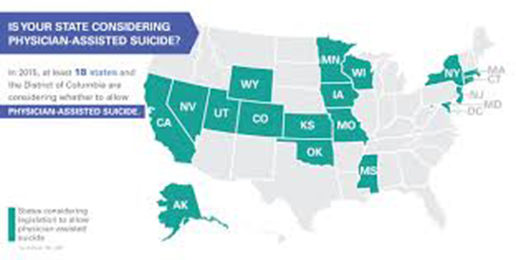
By Ryan T. Anderson, Ph.D.
Allowing physician-assisted suicide (PAS) would be a grave mistake for four reasons, as explained in a Heritage Foundation Backgrounder, “Always Care, Never Kill.”[1] First, it would endanger the weak and vulnerable. Second, it would corrupt the practice of medicine and the doctor–patient relationship. Third, it would compromise the family and intergenerational commitments. And fourth, it would betray human dignity and equality before the law. Instead of helping people to kill themselves, we should offer them appropriate medical care and human presence.
This Issue Brief focuses on how PAS threatens the weak and marginalized. It explores who is most likely to be coaxed into PAS and how PAS has led to voluntary—and even involuntary—euthanasia in Europe. This lethal logic has even been extended to children and the non-terminally ill disabled.
Physician-Assisted Suicide Threatens the Weak and Marginalized
Physician-assisted suicide will most threaten the weak and marginalized because of the cultural pressures and economic incentives that will drive it. The New York State Task Force on Life and the Law, established by Governor Mario Cuomo (D), explained in its report:
The Task Force members unanimously concluded that legalizing assisted suicide and euthanasia would pose profound risks to many patients.…
…The practices will pose the greatest risks to those who are poor, elderly, members of a minority group, or without access to good medical care.…
…The clinical safeguards that have been proposed to prevent abuse and errors would not be realized in many cases.[2]
The people most likely to be assisted by a physician in their suicide are suffering not simply from terminal illness, but also from depression, mental illness, loneliness, and despair. “Researchers have found hopelessness, which is strongly correlated with depression, to be the factor that most significantly predicts the wish for death,” write Dr. Herbert Hendin and Dr. Kathleen Foley. As Dr. Hendin reports:
Mental illness raises the suicide risk even more than physical illness. Nearly 95 percent of those who kill themselves have been shown to have a diagnosable psychiatric illness in the months preceding suicide. The majority suffer from depression that can be treated. This is particularly true of those over fifty, who are more prone than younger victims to take their lives during the type of acute depressive episode that responds most effectively to treatment.[3]
From their decades of professional medical practice, Drs. Hendin and Foley report that when patients who ask for a physician’s assistance in suicide “are treated by a physician who can hear their desperation, understand the ambivalence that most feel about their request, treat their depression, and relieve their suffering, their wish to die usually disappears.”[4] They conclude: “Patients requesting suicide need psychiatric evaluation to determine whether they are seriously depressed, mentally incompetent, or for whatever reason do not meet the criteria for assisted suicide.”[5]
Yet only five of the 178 Oregon patients who died under the Oregon assisted-suicide laws in 2013 and 2014 were referred for any psychiatric or psychological evaluation. Remarkably, patients were referred for psychiatric evaluation in less than 5.5 percent of the 859 cases of assisted suicide reported in Oregon since its law went into effect in 1997.[6] “This constitutes medical negligence,” writes Dr. Aaron Kheriaty. Dr. Kheriaty concludes, “To abandon suicidal individuals in the midst of a crisis—under the guise of respecting their autonomy—is socially irresponsible: It undermines sound medical ethics and erodes social solidarity.”[7]
The World’s Experience with Physician-Assisted Suicide Laws Confirms the Lethal Logic
While many assisted-suicide laws attempt to limit PAS eligibility to the terminally ill, and while many laws attempt to provide protections ensuring autonomous consent, the experience of countries with PAS and euthanasia suggests that safeguards fail to ensure effective control.
In 1989, while teaching law and medical ethics at the University of Cambridge, Professor John Keown began to investigate PAS and euthanasia in the Netherlands. He found that key Dutch guidelines, such as requiring an explicit request from the patient, have long been widely violated with virtual impunity.[8] He pointed out that the first of several official surveys conducted by the Dutch found that in 1990 “the total number of life-shortening acts and omissions where the doctor’s primary intention…was to kill, and which are therefore indubitably euthanasiast, is 10,558.”[9]
Shockingly, the majority of these cases were nonvoluntary. Oxford legal scholar John Finnis, commenting on the Dutch data, remarks: “[W]ell over half…were without any explicit request. In the United States that would be over 235,000 unrequested medically accelerated deaths per annum.”[10] In 2013, 1.7 percent (1,807 patients) of all deaths in Belgium were due to euthanasia and physician-assisted suicide.[11] A 2010 study discovered that 66 of 208 identified deaths in Belgium were administered without an explicit patient request.[12]
Keown confirms that “the undisputed empirical evidence from the Netherlands and Belgium shows widespread breach of the safeguards, not least the sizeable incidence of non-voluntary euthanasia and of non-reporting.”[13] In October of 2013, three judges of the High Court of Ireland voiced the same concern: “[T]he incidence of legally assisted death without explicit request in the Netherlands, Belgium and Switzerland is strikingly high.”[14] And the numbers of those assisted in committed suicide keep growing.[15]
Part of the reason for these troubling statistics is that any purported legal safeguards can be and have been abused, and over time the logic of a “right to die” is extended to ever-wider groups of patients, including the incompetent. Keown describes the logic of PAS as based on judging some lives as unworthy of life:
Once a doctor is prepared to make such a judgment in the case of [a] patient capable of requesting death, the judgment can, logically, equally be made in the case of a patient incapable of requesting death.… If a doctor thinks death would benefit the patient, why should the doctor deny the patient that benefit merely because the patient is incapable of asking for it?… The logical “slippery slope” argument is unanswerable.[16]
Dr. Ezekiel Emanuel, writing in the Atlantic Monthly, affirms that this is the lesson to take from the Netherlands and that proposed American PAS laws cannot avoid the same outcome:
The Netherlands studies fail to demonstrate that permitting physician-assisted suicide and euthanasia will not lead to the nonvoluntary euthanasia of children, the demented, the mentally ill, the old, and others. Indeed, the persistence of abuse and the violation of safeguards, despite publicity and condemnation, suggest that the feared consequences of legalization are exactly its inherent consequences.[17]
The Lethal Logic Extends to Children and Disabled
In 1996, two doctors prosecuted in the Netherlands for the nonvoluntary euthanasia of disabled infants were acquitted when they argued medical necessity.[18] The Dutch courts simply followed the inexorable logic that drives the case for PAS and voluntary euthanasia to a new extent. If necessity justifies ending the life of a suffering patient who requests it, it equally justifies ending the life of a suffering patient who cannot request it. Dutch pediatricians have now devised a protocol for infanticide.[19]
A 2005 study in the New England Journal of Medicine recorded that in the previous seven years, 22 cases of infant euthanasia were reported in the Netherlands.[20] A 2013 Netherlands commission on euthanasia argued that as many as 650 infants per year should be eligible for euthanasia on the basis of the children’s diagnosis as “babies who in spite of very intensive treatment are certain to die in the short term, babies with a poor prognosis and very poor expected quality of life, or babies who are not dependent on intensive treatment but who face a life of severe suffering with no prospect of improvement.”[21] The U.N. Human Rights Committee formally condemned this Dutch infanticide: “The Committee is gravely concerned at reports that new-born handicapped infants have had their lives ended by medical personnel.”[22]
In March 2014, Belgium became the first country to legislatively allow doctors to euthanize “consenting” minors, despite the objections of 160 physicians.[23] In an open letter, these doctors argued that legalization without age restriction was unnecessary, as palliative care is sufficient, and the bill would create excessive pressure on both children and parents to choose premature death.[24] Nevertheless, Belgium went forward and removed the age restrictions.
Diagnoses of disability are now considered sufficient grounds for death. In December 2012, Marc and Eddy Verbessem, 45-year-old deaf twins, were euthanized in a Belgian hospital after they discovered they were going blind.[25] Nancy Verhelst, a 44-year-old transsexual Belgian whose doctors made mistakes in three sex change operations, was left feeling as though she was a “monster.” She then requested—and was granted—euthanasia by lethal injection.[26]
In the Netherlands, the euthanized include Ann G., a 44-year-old woman whose only ailment was chronic anorexia.[27] In the beginning of 2013, Dutch doctors administered a lethal injection to a 70-year-old blind woman because she said the loss of sight constituted “unbearable suffering.”[28] In early 2015, a 47-year-old divorced mother of two suffering from tinnitus, a loud ringing in the ears, was granted physician-assisted suicide in the Netherlands.[29] She left behind a 13-year-old son and a 15-year-old daughter.[30]Gerty Casteelen was a 54-year-old psychiatric patient with molysomophobia, a fear of dirt or contamination. Her doctors decided that she would not be able to control her fear and agreed to administer a lethal injection.[31]
The Alternative: True Compassion and Care
Instead of embracing PAS, we should respond to suffering with true compassion and solidarity.[32]People seeking PAS typically suffer from depression or other mental illnesses, as well as simply from loneliness. Instead of helping them to kill themselves, we should offer them appropriate medical care and human presence. For those in physical pain, pain management and other palliative medicine can manage their symptoms effectively. For those for whom death is imminent, hospice care and fellowship can accompany them in their last days. Anything less falls short of what human dignity requires. The real challenge facing society is to make quality end-of-life care available to all.
Originally posted here























